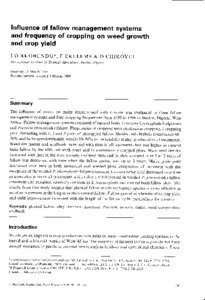| dc.contributor.author | Akobundu, I.O. |
| dc.contributor.author | Ekeleme, F. |
| dc.contributor.author | Chikoye, D. |
| dc.date.accessioned | 2019-12-04T11:26:49Z |
| dc.date.available | 2019-12-04T11:26:49Z |
| dc.date.issued | 1999 |
| dc.identifier.citation | Akobundu, I.O., Ekeleme, F. & Chikoye, D. (1999). Influence of fallow management systems and frequency of cropping on weed growth and crop yield. Weed Research, 39, 241-256. |
| dc.identifier.issn | 0041-3291 |
| dc.identifier.uri | https://hdl.handle.net/20.500.12478/4751 |
| dc.description.abstract | The influence of weeds on maize intercropped with cassava was evaluated in three fallow management systems and four cropping frequencies from 1989 to 1996 in lbadan, Nigeria, West Africa. Fallow management systems consisted of natural bush, Leucaena leucocephala hedgerows and Puerctria phaseoloides lallow. Frequencies of cropping were continuous cropping, I cropping year alternating with I ,2 and 3 years of uncropped fallow. Shrubs and climbers contributed 60- 70o/o and herbs (predominantly weeds) 3040% to the total dry matter produced in all treatments. Weed dry matter and seedbank increased with time in all treatments but was higher in natural bush lallow by the fifth and sixth years and in continuously cropped plots. Weed seed density increased with time in the continuously cropped plots and in plots cropped after I or 2 years of fallow but decreased with time when the fallow period was up to 3 years. Maize grain yield decreased over time in both unweeded and weeded plots irrespective of treatment with the exception of the weeded P. phaseoloides fallow treatment. Cassava tuber yield decreased over time in unweeded plots in all treatments while tuber yield increased in weeded P. pha,seoloide.fsa llow treatment and remained relatively constant in L. leut'ocephala and natural bush fallow plots. The results from this study suggest that planted fallow involving legume species is more effective in weed management in the long term than natural fallow. Fallow period was beneficial to crop yield and yield improvement increased with the length of the fallow cycle, particularly for cassava The influence of weeds on maize intercropped with cassava was evaluated in three fallow management systems and four cropping frequencies from 1989 to 1996 in lbadan, Nigeria, West Africa. Fallow management systems consisted of natural bush, Leucaena leucocephala hedgerows and Puerctria phaseoloides lallow. Frequencies of cropping were continuous cropping, I cropping year alternating with I ,2 and 3 years of uncropped fallow. Shrubs and climbers contributed 60- 70o/o and herbs (predominantly weeds) 3040% to the total dry matter produced in all treatments. Weed dry matter and seedbank increased with time in all treatments but was higher in natural bush lallow by the fifth and sixth years and in continuously cropped plots. Weed seed density increased with time in the continuously cropped plots and in plots cropped after I or 2 years of fallow but decreased with time when the fallow period was up to 3 years. Maize grain yield decreased over time in both unweeded and weeded plots irrespective of treatment with the exception of the weeded P. phaseoloides fallow treatment. Cassava tuber yield decreased over time in unweeded plots in all treatments while tuber yield increased in weeded P. pha,seoloide.fsa llow treatment and remained relatively constant in L. leut'ocephala and natural bush fallow plots. The results from this study suggest that planted fallow involving legume species is more effective in weed management in the long term than natural fallow. Fallow period was beneficial to crop yield and yield improvement increased with the length of the fallow cycle, particularly for cassava |
| dc.language.iso | en |
| dc.subject | Cassava |
| dc.subject | Maize |
| dc.subject | Weeds |
| dc.subject | Fallow |
| dc.subject | Alley Cropping |
| dc.subject | Leucaena |
| dc.title | Influence of fallow management systems and frequency of cropping on weed growth and crop yield |
| dc.type | Journal Article |
| dc.description.version | Peer Review |
| cg.contributor.affiliation | International Institute of Tropical Agriculture |
| cg.coverage.region | Africa |
| cg.coverage.region | West Africa |
| cg.coverage.country | Nigeria |
| cg.isijournal | ISI Journal |
| cg.iitasubject | Cassava |
| cg.iitasubject | Maize |
| cg.iitasubject | Weeds |
| cg.iitasubject | Farming Systems |
| cg.iitasubject | Grain Legumes |
| cg.accessibilitystatus | Limited Access |
| local.dspaceid | 101574 |
| cg.identifier.doi | https://doi.org/10.1046/j.1365-3180.1999.00141.x |

